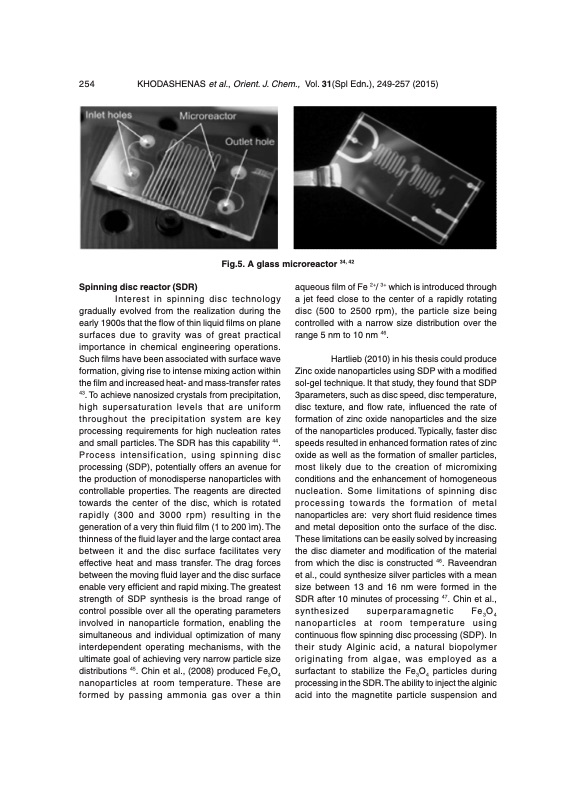
PDF Publication Title:
Text from PDF Page: 006
254 KHODASHENAS et al., Orient. J. Chem., Vol. 31(Spl Edn.), 249-257 (2015) Spinning disc reactor (SDR) Interest in spinning disc technology gradually evolved from the realization during the early 1900s that the flow of thin liquid films on plane surfaces due to gravity was of great practical importance in chemical engineering operations. Such films have been associated with surface wave formation, giving rise to intense mixing action within the film and increased heat- and mass-transfer rates 43. To achieve nanosized crystals from precipitation, high supersaturation levels that are uniform throughout the precipitation system are key processing requirements for high nucleation rates and small particles. The SDR has this capability 44. Process intensification, using spinning disc processing (SDP), potentially offers an avenue for the production of monodisperse nanoparticles with controllable properties. The reagents are directed towards the center of the disc, which is rotated rapidly (300 and 3000 rpm) resulting in the generation of a very thin fluid film (1 to 200 ìm). The thinness of the fluid layer and the large contact area between it and the disc surface facilitates very effective heat and mass transfer. The drag forces between the moving fluid layer and the disc surface enable very efficient and rapid mixing. The greatest strength of SDP synthesis is the broad range of control possible over all the operating parameters involved in nanoparticle formation, enabling the simultaneous and individual optimization of many interdependent operating mechanisms, with the ultimate goal of achieving very narrow particle size distributions 45. Chin et al., (2008) produced Fe3O4 nanoparticles at room temperature. These are formed by passing ammonia gas over a thin aqueous film of Fe 2+/ 3+ which is introduced through a jet feed close to the center of a rapidly rotating disc (500 to 2500 rpm), the particle size being controlled with a narrow size distribution over the range5nmto10nm46. Hartlieb (2010) in his thesis could produce Zinc oxide nanoparticles using SDP with a modified sol-gel technique. It that study, they found that SDP 3parameters, such as disc speed, disc temperature, disc texture, and flow rate, influenced the rate of formation of zinc oxide nanoparticles and the size of the nanoparticles produced. Typically, faster disc speeds resulted in enhanced formation rates of zinc oxide as well as the formation of smaller particles, most likely due to the creation of micromixing conditions and the enhancement of homogeneous nucleation. Some limitations of spinning disc processing towards the formation of metal nanoparticles are: very short fluid residence times and metal deposition onto the surface of the disc. These limitations can be easily solved by increasing the disc diameter and modification of the material from which the disc is constructed 46. Raveendran et al., could synthesize silver particles with a mean size between 13 and 16 nm were formed in the SDR after 10 minutes of processing 47. Chin et al., synthesized superparamagnetic Fe3O4 nanoparticles at room temperature using continuous flow spinning disc processing (SDP). In their study Alginic acid, a natural biopolymer originating from algae, was employed as a surfactant to stabilize the Fe3O4 particles during processing in the SDR. The ability to inject the alginic acid into the magnetite particle suspension and Fig.5. A glass microreactor 34, 42PDF Image | Process Intensification for the Synthesis of Metal Nanoparticles

PDF Search Title:
Process Intensification for the Synthesis of Metal NanoparticlesOriginal File Name Searched:
sdr-synthesis-metal-nanoparticles.pdfDIY PDF Search: Google It | Yahoo | Bing
Turbine and System Plans CAD CAM: Special for this month, any plans are $10,000 for complete Cad/Cam blueprints. License is for one build. Try before you buy a production license. More Info
Waste Heat Power Technology: Organic Rankine Cycle uses waste heat to make electricity, shaft horsepower and cooling. More Info
All Turbine and System Products: Infinity Turbine ORD systems, turbine generator sets, build plans and more to use your waste heat from 30C to 100C. More Info
CO2 Phase Change Demonstrator: CO2 goes supercritical at 30 C. This is a experimental platform which you can use to demonstrate phase change with low heat. Includes integration area for small CO2 turbine, static generator, and more. This can also be used for a GTL Gas to Liquids experimental platform. More Info
Introducing the Infinity Turbine Products Infinity Turbine develops and builds systems for making power from waste heat. It also is working on innovative strategies for storing, making, and deploying energy. More Info
Need Strategy? Use our Consulting and analyst services Infinity Turbine LLC is pleased to announce its consulting and analyst services. We have worked in the renewable energy industry as a researcher, developing sales and markets, along with may inventions and innovations. More Info
Made in USA with Global Energy Millennial Web Engine These pages were made with the Global Energy Web PDF Engine using Filemaker (Claris) software.
Infinity Turbine Developing Spinning Disc Reactor SDR or Spinning Disc Reactors reduce processing time for liquid production of Silver Nanoparticles.
| CONTACT TEL: 608-238-6001 Email: greg@infinityturbine.com | RSS | AMP |